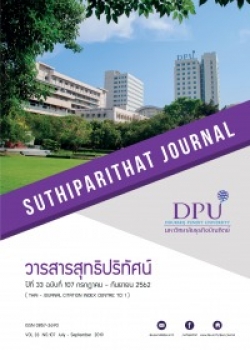การวิเคราะห์ความสามารถในการแข่งขันของ Smart Tourism (การท่องเที่ยวอัจฉริยะ) ในประเทศไทย โดยใช้แนวคิด Diamond Model
คำสำคัญ:
การท่องเที่ยวอัจฉริยะ, ความสามารถในการแข่งขัน, ประเทศไทยบทคัดย่อ
ประเทศไทยได้ใช้ Smart Tourism (การท่องเที่ยวอัจฉริยะ) เป็นหนึ่งในกลยุทธ์เพื่อเพิ่มรายได้ และเพิ่มความสามารถในการแข่งขันจากการท่องเที่ยว อย่างไรก็ตาม ประเทศไทยยังขาดงานวิจัยด้าน Smart Tourism โดยเฉพาะการศึกษาความสามารถในการแข่งขันของ Smart Tourism ดังนั้น บทความนี้จึงมีวัตถุประสงค์เพื่อศึกษาความสามารถในการแข่งขันของ Smart Tourism ในประเทศไทยโดยใช้แนวคิด Diamond Model ของ Porter (1990) และเก็บข้อมูลเชิงคุณภาพจากผู้มีส่วนได้ส่วนเสียในธุรกิจ Smart Tourism ในประเด็นเกี่ยวกับปัจจัยการผลิต ปัจจัยด้านความต้องการของตลาด อุตสาหกรรมที่เกี่ยวข้องและสนับสนุนปัจจัยด้านการแข่งขัน โอกาสและบทบาทภาครัฐ โดยบทความนี้ได้ให้ข้อเสนอแนะสำหรับผู้มีส่วนได้ส่วนเสียในธุรกิจ Smart tourism และต่อยอดงานวิจัยที่จำเป็นสำหรับการพัฒนา Smart tourism ในประเทศไทย
เอกสารอ้างอิง
Arenasa, A., Goh, J., & Urueña, A. (2019). How does IT affect design centricity approaches: Evidence from Spain’s smart tourism ecosystem. International Journal of Information Management, 45(April 2019), 149-162.
Bakan, I., & Dogan, I. (2012). Competitiveness of the industries based on the Porter’s diamond model: An empirical study. International Journal of Research and Reviews in Applied Sciences, 11(3), 441-455.
Baltescu, C. (2018). Smart tourism technologies and sustainable tourism development: Evidence from Brașov County. Annals of the Constantin Brancusi University of Targu Jiu, Economy Series, 3, 58-65.
Boes, K., Buhalis, D., & Inversini, A. (2016). Smart tourism destinations: ecosystems for tourism destination competitiveness. International Journal of Tourism Cities, 2(2), 108-124.
Buhalis, D., & Amaranggana, A. (2013). Smart tourism destinations. New York: Springer.
Buhalis, D., & Leung, R. (2018). Smart hospitality—Interconnectivity and interoperability towards an ecosystem. International Journal of Hospitality Management, 71(April 2018), 41-50.
Deeb, G. (2019). How to build a startup ecosystem. Retrieved 12 May 2019, from https://www.forbes.com/sites/georgedeeb/2019/04/04/how-to-build-a-startup-ecosystem/#4dd5b3476130
Esen, S., & Uyar, H. (2012). Examining the competitive structure of Turkish tourism industry in comparison with diamond model. Procedia - Social and Behavioral Sciences, 62(24 October 2012), 620-627.
Fernando, I., & Long, W. (2012). New conceptual model on cluster competitiveness: A new paradigm for tourism? International Journal of Business and Management, 7(9), 75-84.
Gretzel, U., Sigala, M., Xiang, Z., & Koo, C. (2015). Smart tourism: Foundations and developments. Electronic Markets, 25(3), 179–188.
Gretzel, U., Werthner, H., Koo, C., & Lamsfus, C. (2015). Conceptual foundations for understanding smart tourism ecosystems. Computers in Human Behavior, 50(September 2015), 558-563.
Gretzel, U., Zhang, L., & Koo, C. (2016). Application of smart tourism to cities. International Journal of Tourism Cities, 2(2), Editorial.
Heemmuden, P. (2017). Travel tech: A glittering opportunity for Thai startup. Retrieved December 9, 2018, from https://www.scbeic.com/en/detail/product/4204
Huang, C., Goo, J., Nam, K., & Yoo, C. (2017). Smart tourism technologies in travel planning: The role of exploration and exploitation. Information & Management, 54(6), 757-770.
Huttasin, N., Mommaas, H., & Knippenberg, L. (2015). Towards tourism development of the isan region, northeastern Thailand. International Journal of Asia Pacific Studies, 11(Supplement 1), 103–128.
Kasikorn Bank. (2019). Thailand’s tourism industry outlook 2019. Retrieved May 12, 2019, from https://www.kasikornbank.com/international-business/en/Thailand/IndustryBusiness/Pages/201901_Thailand_TourismOutlook19.aspx
Koo, C., Park, J., & Lee, J. (2017). Smart tourism: Traveler, business, and organizational perspectives. Information & Management, 54, 683–686.
Office of the National Economic and Social Development Board. (2017). The twelfth National Economic and Social Development Plan (2017-2021). Retrieved December 13, 2018, from https://www.nesdb.go.th/nesdb_en/ewt_w3c/ewt_dl_link.php?filename=develop_issue&nid=4345
Özer, K., Latif, H., Sarıısık, M., & Ergün, O. (2012). International competitive advantage of Turkish tourism industry: A comperative analyse of Turkey and Spain by using the diamond model of M. Porter. Procedia - Social and Behavioral Sciences, 58(12 October 2012), 1064-1076.
Porter, M. (1990). The competitive advantage of nations. Boston: Harvard Business School Publishing.
Roland Berger. (2017). Insights on digitalization of Thailand industry: Digital roadmap for aging society, agriculture, and tourism. Retrieved December 9, 2018, from https://www-file.huawei.com/-/media/corporate/pdf/market-trends/thailand_digitalization_whitepaper_en_new.pdf?la=en
Ross, D. (2016). Tourism Authority of Thailand to make tourism smart. Retrieved January 7, 2019, from https://www.ttrweekly.com/site/2016/07/tat-to-make-tourism-smart/
Rotchanakitumnuai, S. (2017). Barriers to Bangkok as a smart destination with internet of things technology. Thammasat Review, 20(2), 1-17.
Saisud, R. (2018). Destination branding strategy towards competitive positioning in destination marketing. ASEAN Journal of Management & Innovation, 5(1), 243 - 254.
Soldatenko, D., & Backer, E. (2019). A content analysis of cross-cultural motivational studies in tourism relating to nationalities. Journal of Hospitality and Tourism Management, 38(March 2019), 122-139.
Vecchio, P., Mele, G., Ndou, V., & Secundo, G. (2018). Creating value from social big data: Implications for smart tourism destinations. Information Processing & Management, 54(5), 847-860.
Wang, K., & Hong, W. (2011). Competitive advantage analysis and strategy formulation of airport city development—The case of Taiwan. Transport Policy, 18(1), 276-288.
Wang, X., Li, X., Zhen, F., & Zhang, J. (2016). How smart is your tourist attraction?: Measuring tourist preferences of smart tourism attractions via a FCEM-AHP and IPA approach. Tourism Management, 54(June 2016), 309-320.
World Economic Forum. (2017). The travel & tourism competitiveness report 2017. Retrieved July 10, 2018, from https://www.weforum.org/reports/the-travel-tourism-competitiveness-report-2017
Xiang, Z., Tussyadiah, L., & Buhalis, D. (2015). Smart destinations: Foundations, analytics, and applications. Journal of Destination Marketing & Management, 4(3), 143-144.
Yoo, C., Goo, J., Huang, C., Nam, K., & Woo, M. (2017). Improving travel decision support satisfaction with smart tourism technologies: A framework of tourist elaboration likelihood and self-efficacy. Technological Forecasting and Social Change, 123(October 2017), 330-341.
ดาวน์โหลด
เผยแพร่แล้ว
รูปแบบการอ้างอิง
ฉบับ
ประเภทบทความ
สัญญาอนุญาต
เนื้อหาและข้อมูลในบทความที่ลงตีพิมพ์ในวารสารสุทธิปริทัศน์ ถือเป็นข้อคิดเห็นและความรับผิดชอบของผู้เขียนบทความโดยตรงซึ่งกองบรรณาธิการวารสาร ไม่จำเป็นต้องเห็นด้วย หรือร่วมรับผิดชอบใด ๆ
บทความ ข้อมูล เนื้อหา รูปภาพ ฯลฯ ที่ได้รับการตีพิมพ์ในวารสารสุทธิปริทัศน์ ถือเป็นลิขสิทธิ์ของวารสารสุทธิปริทัศน์หากบุคคลหรือหน่วยงานใดต้องการนำทั้งหมดหรือส่วนหนึ่งส่วนใดไปเผยแพร่ต่อหรือเพื่อกระทำการใด ๆ จะต้องได้รับอนุญาตเป็นลายลักษณ์อักษรจากวารสารสุทธิปริทัศน์ก่อนเท่านั้น







